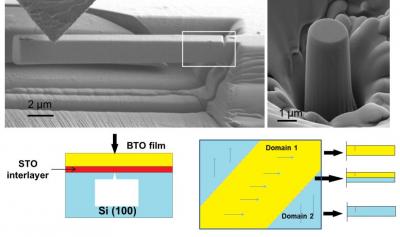
Increasing degree of miniatursation of structures and devices has thrown open new observations in a material's response to different loading environments that are starkly different from that of the bulk. Thin films, nanostructures, MEMS and several other systems belong to this category. The 'smaller is stronger' and 'inverse Hall-Petch effect' are typical size effects that occur when the external surface or internal interface shrinks in size. Brittle materials become more damage tolerant while ductile materials tend to become increasingly brittle at small dimensions.
Our endeavor is to understand material's mechanical behavior at such shrinking external and internal length scales to identify these cross-over regimes. For this, we develop in situ micromechanics tools and geometries to test and observe the deformation and fracture micro-mechanisms of materials (refer images). Further, we use finite element simulation tools to design interface architectures and elucidate stress distributions under various loading conditions. The end objective is to develop strategies to enhance damage tolerance in materials systems.
Ongoing projects, in collaboration with MPIE, Germany; Monash University; ESI-Leoben, Austria; RWTH, Germany, can be classified into interface engineering in brittle and metallic systems, details of which are given below.
Brittle systems
■ Developing geometries for macro and microscale fracture toughness testing including pre-cracking methods and R-curve determination in situ
■ Studying the effect of microstructural parameters [anisotropy, domain ? Vol. II of II | Glimpses of Research | 275 Prof. Nagamani Jaya Balila, Department of Metallurgical Engineering and Materials Science, jayabalila [at] iitb [dot] ac [dot] in Microstructure-macro-mechanical-micro-fracture property correlation in colddrawn pearlitic steels before and after annealing orientation and interface type (sharp and gradient, architectured interfaces)] on damage tolerance of oxides and nitride systems in thin film form to develop strategies to improve their fracture resistance
■ Exploring strategies to extend the versatility of the nano-indentation tool for mechanical behavior studies of brittle materials
Metallic systems
■ Studying the role of processing parameters (severe plastic deformation / annealing conditions) and hard / brittle phase morphology and microstructure on deformation and fracture behavior of dual phase steels and cold drawn pearlitic steels
■ Simulating the stress-strain distribution in multilayered metallic systems with varying bi-layer compositions, thickness and volume fractions under various loading conditions through finite element modeling
■ Determining the length scale and temperature dependence on mechanical behavior and brittle to ductile transition characteristics of precipitation strengthened steels
References:
1) G. Dehm, B. Nagamani Jaya, R. Raghavan and C. Kirchlechner. Overview on micro- and nanomechanical testing: New Insights in Interface Plasticity and Fracture at Small Length Scales. ActaMaterialia, Vol 142, 2017, 248-282
2) B. Nagamani Jaya and VikramJayaram. Fracture testing at small length scales: From plasticity in Si to brittleness in Pt. Review article, Journal of Metals, Vol 68 Issue 1, 2015, 94-108
3) B. Nagamani Jaya, Christoph Kirchlechner and Gerhard Dehm. Fracture behavior of nanostructured heavily cold drawn pearlite before and after annealing. Materials Science and Engineering A, Vol 707, 2017, 164-171
Prof. Nagamani J Balila
